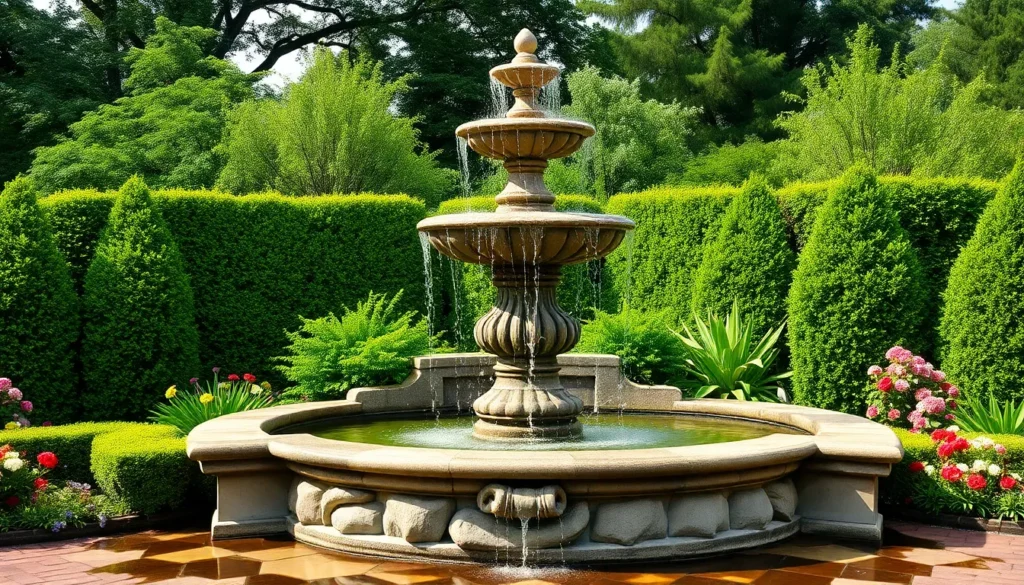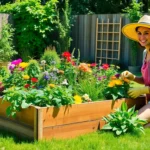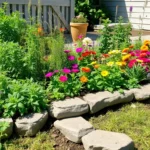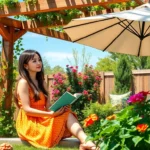Water features transform ordinary outdoor spaces into captivating retreats that soothe the senses and elevate property value. We’ve discovered that adding a fountain to your garden creates an instant focal point while providing the relaxing sounds of flowing water that mask unwanted noise from busy streets or neighbors.
Whether you’re working with a sprawling backyard or a cozy courtyard, fountain options exist for every space and budget. From elegant tiered designs that channel classical elegance to modern minimalist water walls that complement contemporary landscapes, we’ll explore creative answers that fit your unique style and maintenance preferences.
The best part? Many fountain projects don’t require professional installation or extensive plumbing knowledge. We’ll guide you through stunning DIY options alongside more elaborate designs that’ll make your garden the envy of the neighborhood while creating a peaceful sanctuary you’ll never want to leave.
Classic Tiered Stone Fountain Ideas for Traditional Gardens
Stone fountains create timeless elegance that perfectly complements traditional garden landscapes. These classic designs bring sophisticated water features that enhance outdoor spaces with natural beauty and soothing sounds.
Three-Tier Limestone Centerpiece Designs
Limestone three-tier fountains serve as stunning focal points in traditional gardens with their warm, creamy tones and elegant proportions. We recommend positioning these centerpieces in circular garden beds surrounded by boxwood hedges or colorful perennials like roses and lavender.
Popular limestone fountain styles include:
- Fluted bowl designs with decorative ribbing that catches light beautifully
- Smooth basin options featuring clean lines and subtle curves
- Ornate carved versions with intricate floral or geometric patterns
- Weathered finish styles that develop natural patina over time
Installation requires a solid concrete foundation measuring at least 6 feet in diameter to support the fountain’s weight of 800-1,200 pounds. These fountains typically stand 4-6 feet tall and work best in gardens with at least 200 square feet of open space.
Carved Granite Multi-Level Fountain Options
Granite multi-level fountains offer exceptional durability and striking visual impact with their rich colors ranging from charcoal gray to warm pink hues. We’ve found these fountains work exceptionally well in formal garden settings where their substantial presence commands attention.
Premium granite fountain features include:
- Four-tier configurations creating dramatic cascading water effects
- Polished surfaces that reflect sunlight and surrounding plantings
- Hand-carved details including acanthus leaves, scrollwork, and animal motifs
- Color variations such as black granite, red granite, and speckled varieties
These robust fountains weigh between 1,500-2,500 pounds and require professional installation with reinforced foundations. Granite’s natural resistance to weathering ensures these fountains maintain their beauty for decades with minimal maintenance.
Natural Fieldstone Cascading Water Features
Fieldstone cascading fountains blend seamlessly with naturalistic garden designs using locally sourced stones that reflect regional geology. We appreciate how these rustic fountains create organic water movement that mimics natural streams and waterfalls.
Fieldstone fountain characteristics include:
- Irregular stone shapes that create unique water flow patterns
- Moss-friendly surfaces that develop beautiful green accents naturally
- Variable heights ranging from 2-5 feet depending on stone availability
- Regional stone types like river rock, sandstone, or slate variations
Construction involves stacking stones with hidden mortar joints and concealed pump systems that circulate 200-400 gallons per hour. These fountains cost significantly less than carved stone options while providing authentic natural beauty that attracts birds and wildlife to your garden space.
Modern Minimalist Fountain Concepts for Contemporary Spaces
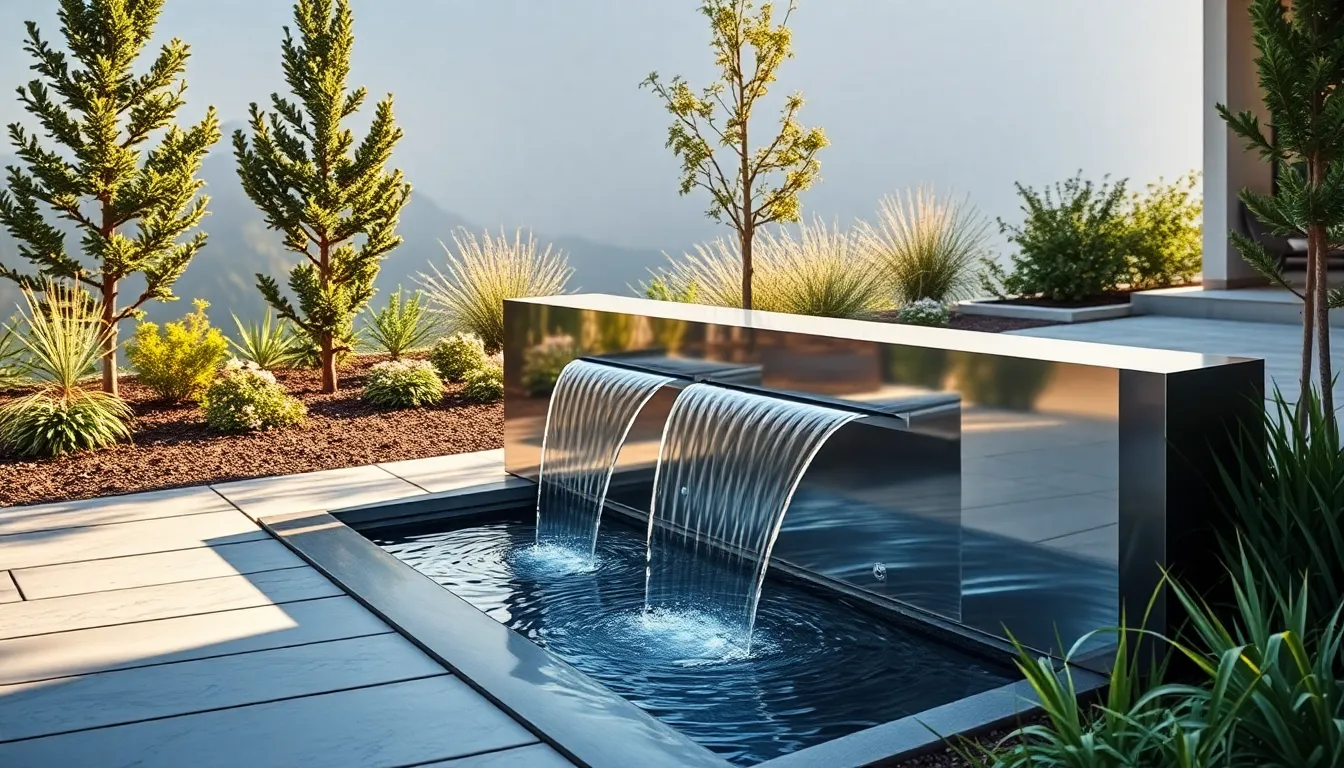
We’ve moved beyond traditional fountain designs to embrace clean lines and sophisticated materials that complement today’s architectural trends. Contemporary fountain concepts focus on simplicity while creating dramatic visual impact through innovative materials and geometric forms.
Sleek Stainless Steel Linear Water Features
Stainless steel linear fountains offer unmatched sophistication for modern outdoor spaces. These long, rectangular designs create elegant water displays that stretch across patios or serve as property borders. We recommend installing these features along walkways where their sleek profiles can guide visitors through your garden. The reflective surface of stainless steel amplifies natural light while the linear water flow produces a consistent, calming sound. These fountains work particularly well in urban settings where their industrial aesthetic complements contemporary architecture. Installation requires level ground and proper drainage, but the minimal maintenance and weather resistance make them ideal for busy homeowners.
Geometric Concrete Fountain Installations
Concrete fountains embrace bold geometric patterns that serve as sculptural focal points in contemporary gardens. These customizable installations can feature triangular cascades, circular basins, or angular water channels that create striking visual interest. We’ve seen stunning examples where geometric concrete fountains incorporate multiple levels and unexpected angles that transform ordinary spaces into artistic landscapes. The versatility of concrete allows for custom colors, textures, and finishes that match your existing hardscape elements. These installations can be designed to fit any garden style, from stark minimalist designs to more elaborate geometric patterns. Proper reinforcement and waterproofing ensure these fountains remain durable focal points for years.
LED-Illuminated Contemporary Water Walls
LED illuminated water walls create spectacular evening displays that transform outdoor entertaining spaces. These vertical fountains feature sheets of water flowing down smooth surfaces while strategically placed LED lights create stunning visual effects. We recommend positioning these features where they can serve as dramatic backdrops for outdoor dining areas or conversation spaces. The combination of moving water and colored lighting creates an ever-changing artistic display that captivates guests throughout the evening. Modern LED systems offer programmable color sequences and energy efficient operation that keeps maintenance costs low. These water walls work exceptionally well in small spaces where vertical design maximizes impact without consuming valuable floor space.
DIY Budget-Friendly Garden Fountain Projects
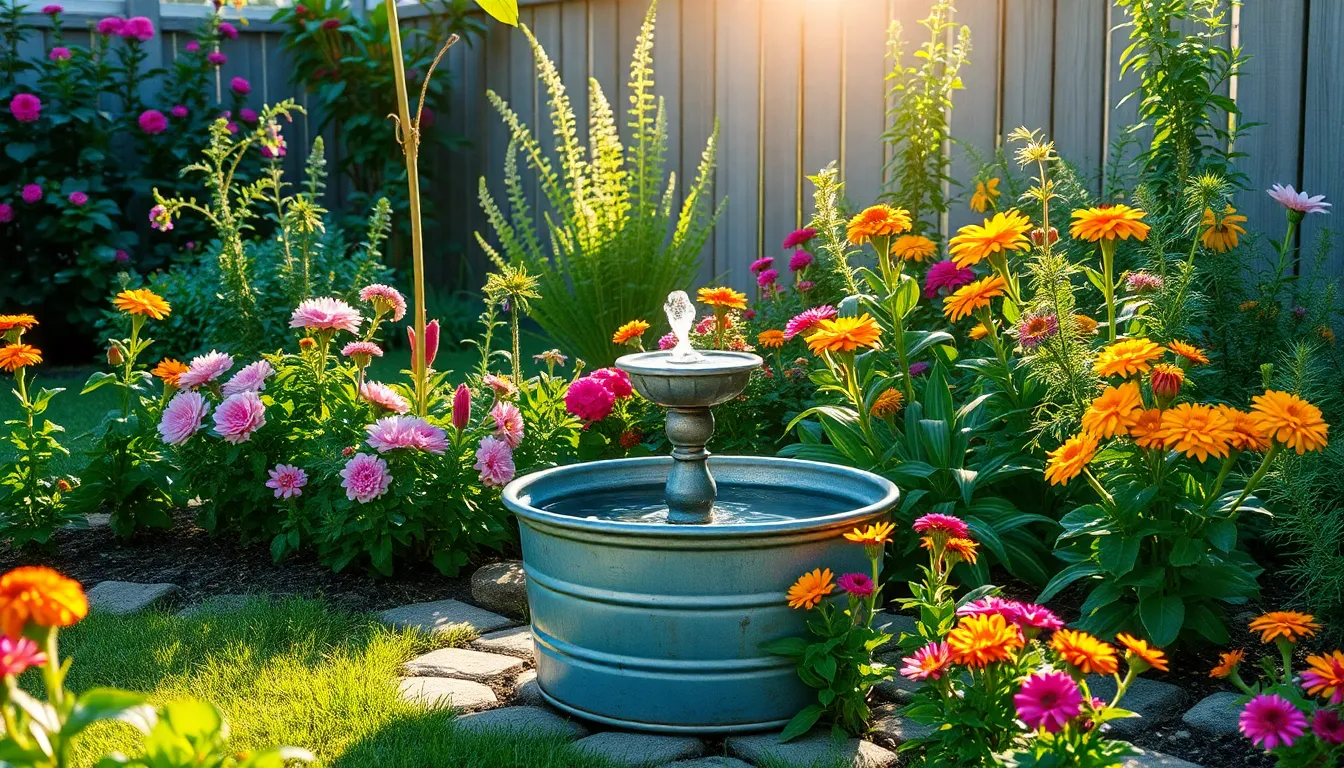
Creating beautiful water features doesn’t require a massive budget or professional installation. We’ll explore affordable DIY fountain projects that transform everyday containers and materials into stunning garden centerpieces.
Repurposed Container Fountain Tutorials
Galvanized bucket solar fountains offer an excellent starting point for beginners looking to create portable water features. Transform leftover galvanized tubs into solar-powered fountains that you can easily transport and set up anywhere in your garden. These containers provide excellent durability while maintaining that rustic charm that complements country garden aesthetics.
Wine bottle fountains turn discarded bottles into unique and calming water features that add personality to your outdoor space. Upcycle your favorite wine bottles by incorporating them into cascading fountain designs that create gentle trickling sounds. Stack multiple bottles at different heights to achieve varying water flow patterns.
Rock fountains combine submersible pumps with carefully stacked stones to create visually appealing natural water features. Position larger stones as the base and gradually layer smaller rocks to build height and create interesting water pathways. This project typically requires a couple of days to complete but delivers impressive results that blend seamlessly with natural garden landscapes.
Simple Solar-Powered Water Feature Ideas
Solar fountain kits eliminate electricity costs while providing easy setup options for water feature enthusiasts. These kits often include everything needed for installation and require minimal maintenance once established. Choose from various pump strengths depending on your desired water flow and fountain height requirements.
Vanishing waterfalls planter pot fountains create self-sustaining waterfall effects using solar power technology. Design these features by nesting different sized pots to achieve cascading water movement. Solar panels charge during daylight hours and power the water circulation throughout the day.
Whiskey barrel water fountains transform rustic containers into charming focal points using solar pump systems. Add a solar fountain kit to a whiskey barrel basin for a quick assembly project that delivers authentic country garden appeal. Retailers like Walmart offer complete kits that simplify the construction process.
Affordable Pump and Basin Combinations
Ceramic pot fountain groupings allow customization with various container sizes to create ever-changing water displays. Use ceramic pots of different dimensions to establish fountain clusters that provide multiple water sounds and visual interest. Stack smaller pots on top of larger ones to achieve tiered effects without expensive materials.
Pump and bucket setups combine basic equipment to create simple and effective fountain systems. Select containers that complement your garden style while ensuring adequate space for pump installation. These straightforward combinations work well for gardeners wanting immediate results without complex assembly requirements.
Bubbling globe water fountains use lightweight resin globes that you can easily move around your garden as needed. Create these fountains from scratch or purchase lightweight globe options that won’t require permanent installation. Position these portable features near seating areas to maximize their relaxing bubble sounds and visual appeal.
Small Space Fountain Solutions for Compact Gardens
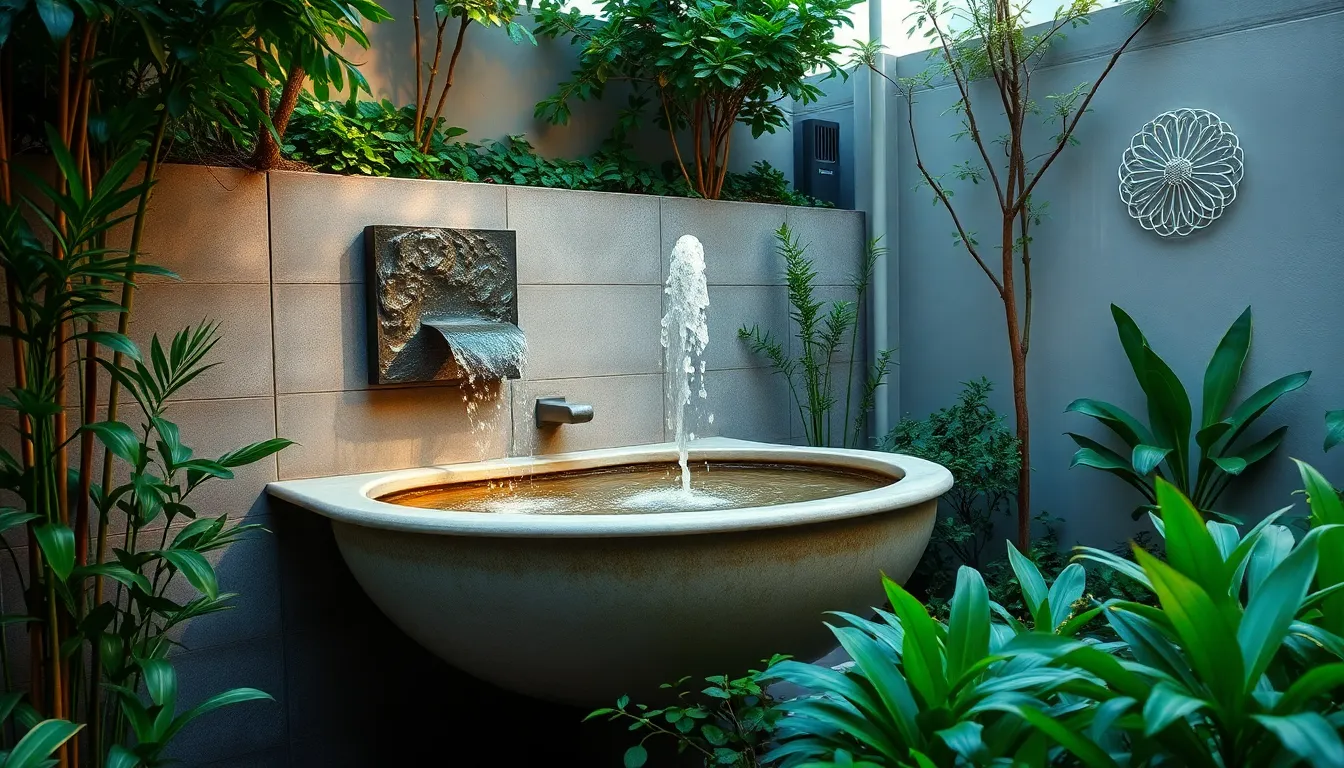
We’ve discovered that limited garden space doesn’t mean sacrificing the tranquil beauty of water features. Small outdoor fountains offer the perfect solution for compact gardens and patios, delivering ambiance without overwhelming your available space.
Corner Fountain Designs for Tight Areas
Corner fountains transform underutilized garden corners into stunning focal points without intruding into your main garden space. Multi-tiered basin style fountains work exceptionally well in these confined areas, allowing water to cascade both visually and audibly within a compact footprint. Three-tier fountains provide soothing sounds and elegant visual appeal while requiring minimal floor area.
Maximizing these often forgotten spaces, corner fountain designs create dramatic impact in tight garden layouts. Basin style configurations allow for easy maintenance and water circulation in areas where traditional fountains wouldn’t fit. Strategic placement in garden corners adds vertical interest and draws the eye naturally through your outdoor space.
Vertical Wall-Mounted Water Features
Wall-mounted fountains save precious floor space while adding sophisticated vertical interest to small patios and urban gardens. Mini wall fountains typically project just 6 to 12 inches from the wall, making them perfect for narrow walkways, small courtyards, or balconies where floor space comes at a premium. These space-saving features create tranquil water sounds without sacrificing valuable garden real estate.
Accenting these vertical water features with plants around the base or on nearby ledges softens their structure and integrates them seamlessly into your garden design. Contemporary or natural aesthetic options allow you to match your existing outdoor décor perfectly. Installation flexibility means you can position them at eye level for maximum visual and auditory impact.
Tabletop and Container Garden Fountains
Tabletop outdoor fountains represent the most versatile solution for small gardens, typically measuring 8 to 18 inches tall and fitting perfectly on patio tables or deck railings. These compact water features require minimal water and produce subtle sounds ideal for intimate outdoor dining or relaxation areas. Simple water circulation systems make maintenance effortless while delivering maximum sensory appeal.
Container fountains integrate water features directly with your existing plants, using pots or planters as decorative basins. DIY projects or complete purchased units work equally well for decks, balconies, or small garden spaces. Combining water elements with flora creates ever-changing displays that change with your seasonal plantings.
| Fountain Type | Height Range | Water Requirement | Best Location |
|---|---|---|---|
| Tabletop Outdoor | 8-18 inches | Minimal | Patio tables, deck railings |
| Small Garden | 18-30 inches | Low | Garden beds, corners |
| Mini Wall | 6-12 inch projection | Very low | Walkways, courtyards |
| Container | Variable | Moderate | Decks, balconies |
Large Statement Fountain Ideas for Spacious Landscapes

Expansive gardens offer incredible opportunities to create breathtaking water features that serve as commanding focal points. Large statement fountains transform spacious landscapes into luxurious outdoor sanctuaries where dramatic water displays capture attention from every angle.
Grand Central Fountain Placement Strategies
Central garden placement creates the most stunning visual impact by positioning your fountain as the primary focal point. We recommend surrounding tiered fountains like the Charleston Fountain or Estate Longvue Fountain with colorful blooms, manicured hedges, or elegant stone pathways that draw visitors naturally toward the water feature.
Entryway positioning establishes a dramatic first impression by using large fountains as commanding centerpieces in courtyards or main entrances. These installations set a luxurious tone that welcomes guests with the soothing sounds of cascading water over sculpted bowls.
Reflective oasis creation transforms fountain areas into serene spaces by surrounding the water feature with lush greenery and comfortable seating arrangements. This strategy encourages relaxation and contemplation while maximizing the therapeutic benefits of flowing water sounds.
Strategic lighting enhancement elevates fountain placement through solar powered lights or carefully positioned spotlights that create magical nighttime ambiance. These illumination techniques highlight the sculptural elements and water movement, extending the fountain’s visual appeal well into evening hours.
Multi-Zone Water Feature Complexes
Coordinated fountain pairing combines large outdoor fountains with complementary features like garden outdoor fountains or outdoor wall fountains to create cohesive industry designs. This approach establishes visual rhythm throughout spacious properties while maintaining design consistency across different garden zones.
Diverse element integration incorporates various water features including bubblers, small ponds, and cascading installations to create captivating multi-sensory experiences. These complex arrangements offer visitors different perspectives and interaction points as they move through the industry.
Material coordination ensures striking sculptures made from cast stone or metal complement each fountain element while maintaining artistic unity. This design philosophy creates sophisticated outdoor galleries where water features serve as both functional and sculptural installations.
Pond Integration with Fountain Elements
Pond fountain installation integrates water features directly into existing pond systems through floating fountains or strategically placed submerged jets. These combinations create harmonious blends of water sounds and visual effects that enhance the natural network while providing dramatic focal points.
Water circulation management maintains optimal water quality by ensuring proper flow between pond and fountain elements. This technical approach prevents algae buildup while creating continuous water movement that supports both aesthetic appeal and ecological health.
Network enhancement attracts wildlife through carefully designed water features that provide drinking sources and habitat elements. These integrated systems transform large landscapes into thriving outdoor environments where fountains serve multiple functional purposes beyond mere decoration.
Natural and Rustic Fountain Designs
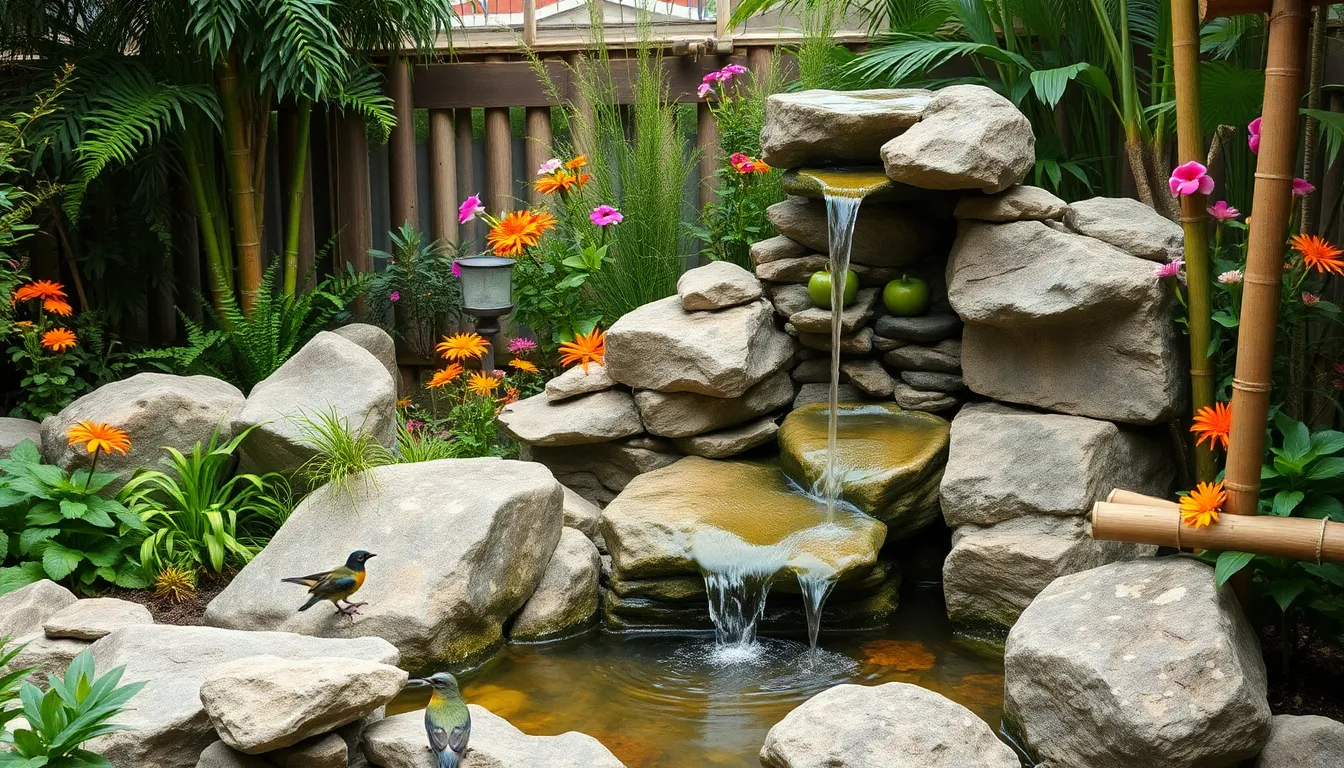
Natural fountain designs bring organic beauty to outdoor spaces through materials that harmonize with surrounding landscapes. We’ll explore rustic concepts that create seamless connections between your water features and garden environment.
Rock Garden Waterfall Fountain Ideas
Rock cascades offer the most authentic way to create natural waterfall effects that blend perfectly into existing garden landscapes. We recommend using locally sourced stones to match your regional geology and create a truly organic appearance. Natural rocks stack together to form multi-level water paths that guide water from higher elevations down through carefully positioned ledges.
Boulder fountains incorporate dramatic large stones as centerpieces that command attention while maintaining rustic appeal. These installations use single massive rocks or grouped boulder arrangements with water emerging from natural crevices or drilled openings. Positioning varies from solitary statement pieces to clustered formations that mimic natural rock outcroppings found in mountain streams.
Fieldstone arrangements create cascading water features using smaller weathered stones that appear naturally deposited over time. The irregular shapes and varied sizes of fieldstone allow for organic stacking patterns that produce different water sounds as streams flow over textured surfaces.
Bamboo and Wood Water Feature Concepts
Bamboo waterfalls bring Asian-inspired tranquility to gardens through natural materials that produce gentle flowing sounds in serene settings. Traditional bamboo fountain designs use hollow bamboo sections as water channels that guide streams from source points to collection basins below. Installing bamboo requires treating the material to prevent decay while maintaining its natural appearance and acoustic properties.
Wooden fountain basins combine rustic wooden containers with natural stone elements to create appealing multi-material designs. Cedar and teak work exceptionally well for outdoor fountain basins due to their natural weather resistance and attractive grain patterns. These wooden elements pair beautifully with river rocks, slate, or granite to create striking contrasts in texture and color.
Reclaimed wood water features use salvaged barn wood, driftwood, or weathered lumber to construct unique fountain frameworks that tell environmental stories. The aged patina and natural weathering of reclaimed materials adds instant character that new materials cannot replicate.
Wildlife-Friendly Fountain Installations
Bird-friendly fountains incorporate shallow water features and surrounding plants to attract local bird populations seeking drinking and bathing opportunities. The Medium Oslo Fountain serves as an excellent example of wildlife-friendly design that provides accessible water depths for various bird species. Shallow basin edges allow small birds to wade safely while deeper central areas accommodate larger species.
Creating bird habitats requires positioning fountains near protective shrubs or trees that offer perching spots and escape routes from predators. Native plant selections around fountain perimeters provide food sources and nesting materials that encourage bird visits throughout different seasons.
Pond fountains with integrated plants create comprehensive wildlife habitats that support local fauna beyond just birds. These installations combine water circulation systems with aquatic plants, emergent vegetation, and surrounding native landscaping to establish mini ecosystems. Frogs, beneficial insects, and small mammals benefit from these comprehensive water feature environments that provide drinking water, food sources, and shelter opportunities.
Themed Garden Fountain Inspirations
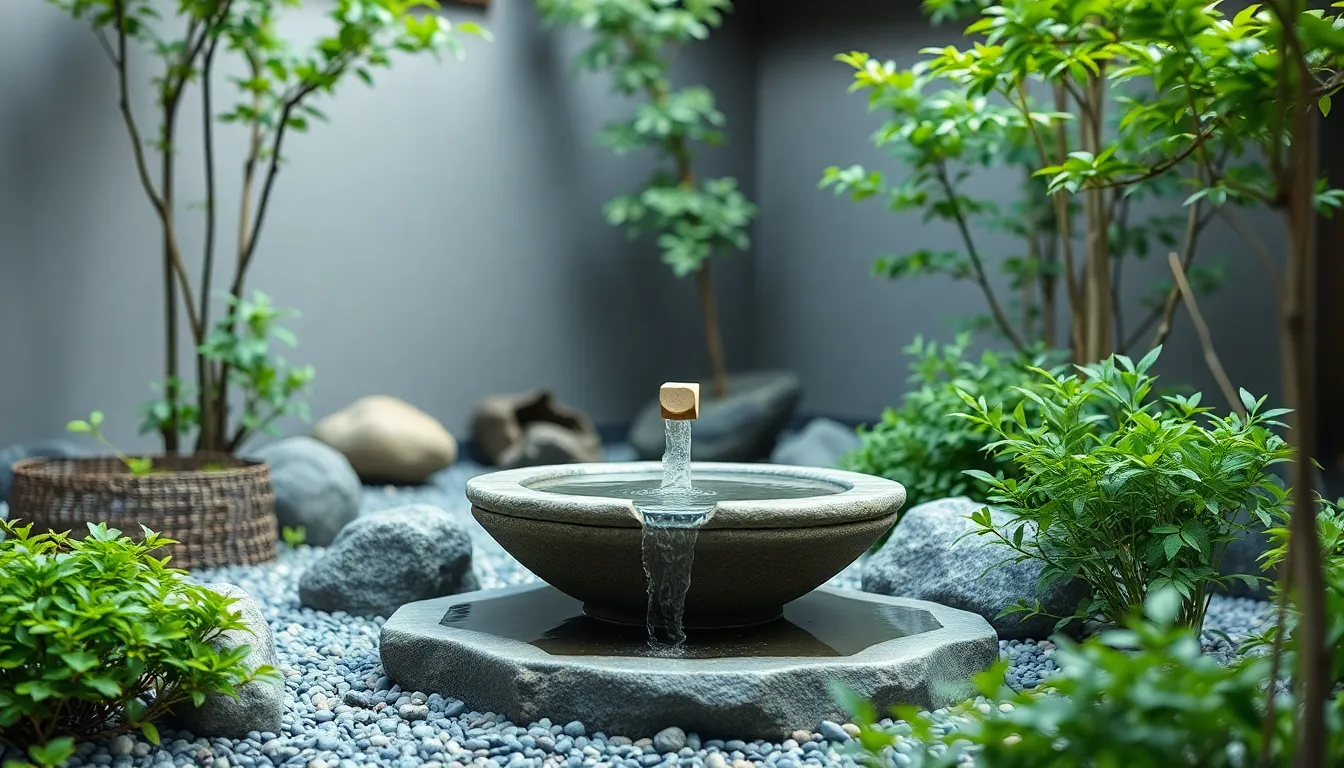
Drawing inspiration from different cultural traditions can transform your garden fountain into a meaningful focal point that reflects exact aesthetic philosophies and design principles.
Mediterranean-Style Courtyard Fountains
Mediterranean style courtyard fountains bring the warmth and charm of southern Europe directly to your outdoor space. These fountains feature ornate tile work, terracotta finishes, and stucco surfaces that create a rustic atmosphere reminiscent of Spanish and Italian courtyards. Tiered structures and wall mounted designs dominate this style, often enhanced with colorful Moorish inspired tiles that add visual richness to the water feature.
We recommend positioning these fountains as centerpieces in courtyards or patios where they can complement lush greenery and vibrant flower displays. The gentle water sounds create a sensory experience that enhances outdoor dining and relaxation areas. Terracotta materials and warm earth tones work particularly well in Mediterranean themed gardens, blending seamlessly with olive trees, lavender, and other Mediterranean plants.
Japanese Zen Garden Water Elements
Japanese Zen garden water elements emphasize simplicity and tranquility through understated design that promotes mindfulness and reflection. These fountains often incorporate bamboo spouts, known as shishi-odoshi, or stone basins that create gentle, rhythmic water sounds perfect for meditation areas. Natural stone materials and minimalist aesthetics define this style, ensuring the fountain blends seamlessly with surrounding natural elements.
Stone basins serve as both functional and symbolic elements in Zen garden designs, representing purification and renewal. We suggest placing these water features in quiet garden corners or alongside walking paths where visitors can pause for contemplation. The rhythmic sounds of water dripping or flowing create an auditory backdrop that enhances the peaceful atmosphere essential to Zen garden philosophy.
English Garden Traditional Fountain Styles
English garden traditional fountain styles showcase classical elegance through formal designs that serve as sophisticated focal points in established landscapes. These fountains typically feature elegant sculptures, decorative urns, or tiered basins crafted from cast stone or bronze materials that reflect historical garden traditions. Symmetrical designs and harmonious proportions characterize this style, creating timeless appeal that complements formal garden layouts.
Formal integration into lush lawns, established flowerbeds, and structured garden pathways defines the English garden approach to fountain placement. We recommend incorporating these fountains into garden rooms or formal parterre designs where their classical styling can anchor the overall industry composition. The emphasis on symmetry and traditional materials ensures these fountains maintain their elegant appearance while providing the soothing sounds of flowing water that enhance the garden’s tranquil atmosphere.
Seasonal Fountain Maintenance and Winterization Tips
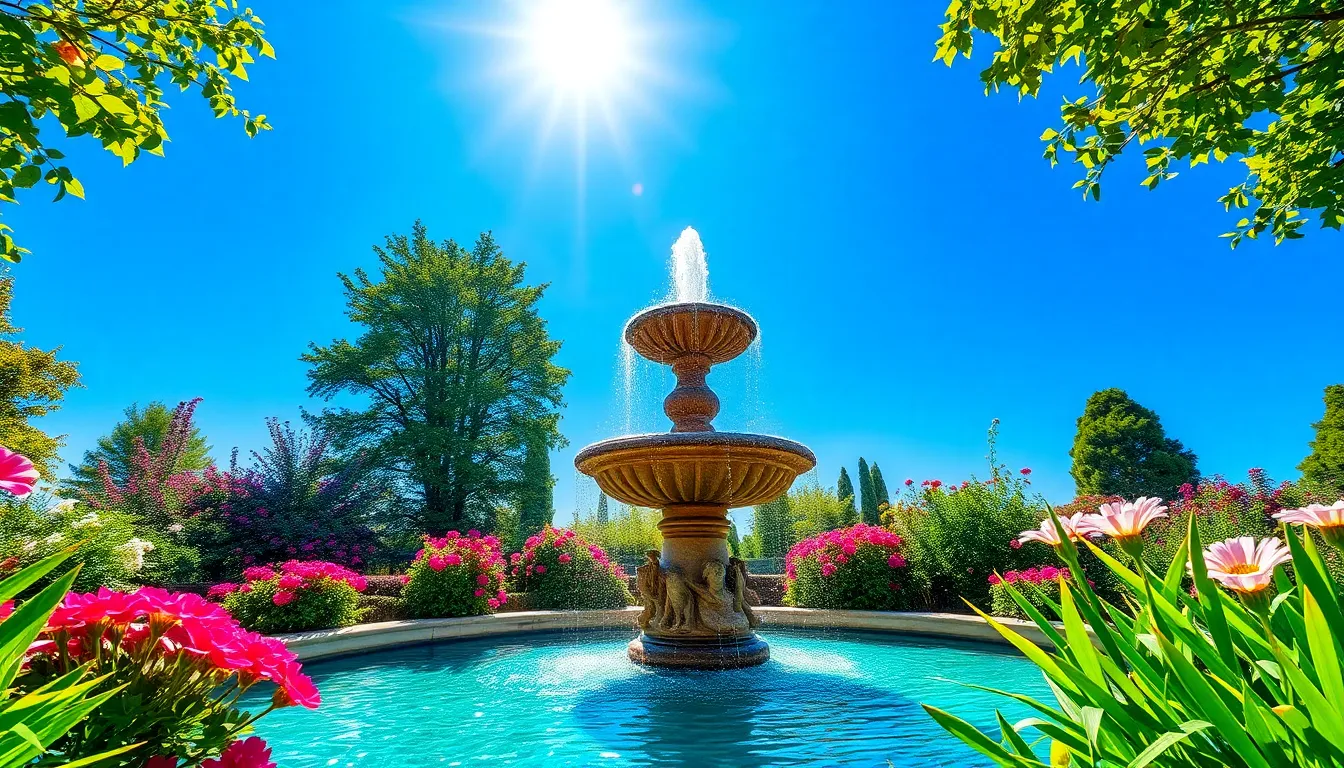
Proper seasonal maintenance ensures your garden fountain remains a stunning centerpiece throughout the year while protecting your investment from weather-related damage.
Spring Startup and Cleaning Procedures
Thorough cleaning of your fountain components marks the essential first step in spring maintenance. We recommend removing all debris like fallen leaves, twigs, and accumulated sediment from the basin and fountain surfaces using a soft brush and mild detergent solution.
Filter maintenance requires careful inspection and cleaning to restore proper water circulation after winter dormancy. Clean or replace filters according to manufacturer specifications, as clogged filters can strain your pump system and reduce water flow efficiency.
Pump inspection involves checking all electrical connections, examining the impeller for damage, and testing the pump’s performance before the active season begins. Replace worn pump components immediately to prevent costly repairs later, and ensure all seals remain watertight for optimal operation.
Water quality testing helps establish baseline conditions for the upcoming season. Test pH levels and add appropriate water treatments to create an optimal environment for your fountain’s operation and any aquatic life you plan to introduce.
Summer Water Level and Algae Management
Regular water level monitoring prevents pump damage and maintains consistent fountain performance during hot weather. We suggest checking water levels weekly, as evaporation rates increase significantly during summer months, potentially exposing pump components to harmful dry conditions.
Algae control strategies become crucial during warm weather when sunlight and nutrients promote rapid algae growth. Use algae control products specifically designed for fountains, or introduce beneficial bacteria that naturally compete with algae for nutrients while maintaining water clarity.
Shade creation around your fountain area helps reduce algae growth and slows evaporation rates. Consider adding umbrella structures, pergolas, or strategic plant placement to provide partial shade during peak sun hours.
Water circulation optimization ensures even distribution of treatments and prevents stagnant areas where algae typically flourish. Adjust fountain heads or add additional circulation pumps if needed to maintain consistent water movement throughout the entire system.
Winter Protection and Storage Answers
Complete drainage of your fountain system prevents freeze damage that can crack basins and damage internal components. We recommend draining all water from the fountain, basin, and connecting pipes before the first hard freeze occurs in your area.
Pump and equipment storage requires removing all electrical components and storing them in a dry, temperature-controlled environment. Clean pumps thoroughly, dry all surfaces completely, and store in protective containers to prevent moisture damage during inactive months.
Basin protection involves covering your fountain with weather-resistant materials or specialized winter covers designed for outdoor water features. Secure covers properly to prevent wind damage while allowing air circulation to prevent condensation buildup.
Plumbing winterization includes blowing out any remaining water from pipes and adding antifreeze to systems that cannot be completely drained. Mark electrical connections and take photographs of complex setups to simplify spring reassembly processes.
Conclusion
We’ve explored an incredible range of fountain possibilities that can transform any outdoor space into a personal oasis. Whether you’re drawn to timeless stone elegance or contemporary minimalist designs there’s a perfect water feature waiting to enhance your garden’s ambiance.
The beauty of fountain gardening lies in its accessibility—you don’t need unlimited space or budget to create something magical. From simple DIY container projects to elaborate multi-zone complexes every garden can benefit from the soothing presence of flowing water.
Remember that proper maintenance will keep your fountain running smoothly year-round ensuring you’ll enjoy its peaceful sounds and visual appeal for seasons to come. Your garden fountain journey starts with a single splash of inspiration.
Frequently Asked Questions
What are the main benefits of adding a fountain to my garden?
Fountains provide aesthetic appeal and create soothing sounds that help drown out unwanted noise. They serve as stunning focal points, add tranquil ambiance to outdoor spaces, and can attract wildlife like birds. Water features also increase property value while creating peaceful retreats for relaxation and contemplation.
Can I install a garden fountain myself, or do I need professional help?
Many fountain projects can be tackled as DIY endeavors, especially simple designs like container fountains and solar-powered features. Basic projects require minimal tools and plumbing knowledge. However, complex installations with electrical work, large stone fountains, or permanent plumbing connections may benefit from professional installation.
What fountain styles work best for small gardens or patios?
Corner fountains, wall-mounted water features, and tabletop container fountains are ideal for compact spaces. These designs maximize vertical space while providing the tranquil benefits of water features. Solar-powered options eliminate electrical requirements, making them perfect for small patios and urban gardens.
How much does it cost to create a DIY garden fountain?
DIY fountain costs vary widely based on materials and complexity. Simple container fountains using repurposed items can cost under $100, while more elaborate stone or multi-tier designs may range from $200-500. Solar pumps and basic materials keep costs affordable for most budgets.
What maintenance do garden fountains require throughout the year?
Spring requires thorough cleaning, filter maintenance, and pump inspection. Summer focuses on water level management and algae control. Winter maintenance involves complete drainage, pump storage, and basin protection from freeze damage. Regular cleaning and seasonal care ensure fountain longevity and optimal performance.
Which fountain materials are most durable for outdoor use?
Stone fountains, particularly granite and limestone, offer exceptional durability and timeless appeal. Stainless steel provides modern aesthetics with weather resistance. Concrete fountains are highly durable and customizable. Choose materials that complement your garden style while withstanding local climate conditions.
How do I choose the right fountain size for my landscape?
Consider your available space and desired visual impact. Large landscapes can accommodate statement fountains as central focal points, while small gardens benefit from compact designs. The fountain should be proportional to surrounding elements and not overwhelm the space or appear too small.
What are the best fountain options for attracting wildlife?
Natural stone fountains with shallow basins, bubbling features, and gentle water movement attract birds and beneficial insects. Multi-level designs provide various water depths for different wildlife species. Position fountains near native plants and shelter areas to create comprehensive wildlife-friendly habitats.

